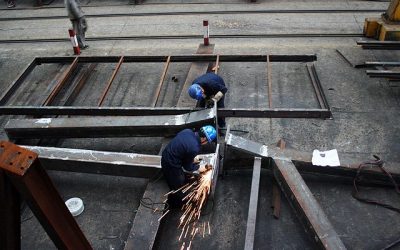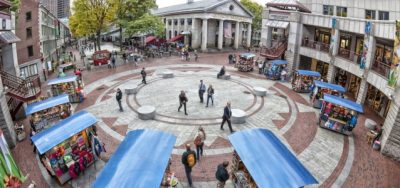Demographics
Immigrants are a vital, dynamic part of the U.S. population—especially when it comes to the workforce. 77.1% of immigrants are of working age (16–64), compared to just 62.0% of U.S.-born residents, making them key contributors to the economy as both taxpayers and consumers.
- 22.9 million immigrants are active in the U.S. workforce
- 74% of foreign-born residents are proficient in English
- 89.4% of all undocumented immigrants are of working age
- 5.2 million U.S. citizen children living with at least one undocumented family member
- Only 4.9% of immigrants are under 15, compared to 20.3% of U.S.-born residents
- 18% of immigrants are 65+, nearly identical to the 17.7% of U.S.-born seniors

How the 2014 Midterm Elections Could be Impacted by Immigration
By Tom K. Wong, Ph.D., Assistant Professor of Political Science at the University of California, San Diego. Despite hopes that 2013 would be the year of comprehensive immigration reform, legislation stalled in the House and the year ended without a bill. Since the House reconvened Tuesday, 427 days have passed since the November 2012 elections and 194 days since S.744, the Senate comprehensive immigration reform bill that includes a path to citizenship, passed by a vote of 68 to 32. Whether they realize it or not, the political fortunes of some may rise or fall this year based on the position they take on immigration reform. Read More

How Latino and Asian Voters Made the Difference in 2013 Gubernatorial Elections
In a Dickensian tale of two campaigns for governor, the Republican Party watched two very different strategies unfold on how to embrace or reject Latino voters on Tuesday. A majority of Latino voters voted for New Jersey Gov. Chris Christie as he soundly won reelection, while Ken Cuccinelli lost his campaign to be Virginia’s governor after alienating Latinos with his anti-immigrant positions. As Jordan Fabian at Fusion explains, Christie offered Republicans a path for how to make inroads with Latinos, but “Cuccinelli’s campaign, on the other hand, fell into the same traps that have doomed Republicans in the last two elections.” Read More

How Immigrants on a Pathway to Citizenship can Revitalize Rust Belt Cities
Like Rust Belt cities such as Baltimore and Detroit, rural towns across America have experienced population declines in recent decades. Some places, however, are an exception to that trend thanks in part to the arrival of immigrants. For example, while other Iowa towns experienced population decline over the past several decades, West Liberty’s population grew because of immigration. As Steve Hanson, superintendent of West Liberty Community School District, notes, “in the last 20-30 years we would have had a population decline if we hadn’t had immigrants come in [for] jobs in the food manufacturing business. They provide a source of labor that wouldn’t have been there.” And West Liberty’s Mayor, Chad Thomas, said immigration has “kept a lot of storefronts and businesses open that probably otherwise would have closed.” Read More

It’s Immigrant Entrepreneurship Month in Massachusetts!
Massachusetts is no stranger to the many benefits immigrant entrepreneurs bring to communities. From family owned restaurants and shops along small town main streets, to large Fortune 500 companies, immigrant-owned businesses make sizeable contributions to Massachusetts. And as a growing number of places around the country make efforts to attract and welcome immigrants, Massachusetts continues to expand the state’s efforts. October 15 marked the start of the third annual Massachusetts Immigrant Entrepreneurship Month, which will officially run through November 15. State groups—including the Immigrant Learning Center (ILC), the New Americans Integration Institute at the Massachusetts Immigrant and Advocacy Coalition (MIRA), and the state’s Office for Refugees and Immigrants—are leading the initiative, which recognizes the contributions of immigrant business owners and innovators to Massachusetts’ economic development. Read More

From Coast to Coast, Immigrants Drive Local Economies
Immigrant entrepreneurship has transformed Atlanta’s northeastern suburbs along and near Buford Highway into “International Village” – an area filled with immigrant restaurants, markets, specialty stores, and other businesses. Through ventures such as Chinatown Square, Asian Square Mall, and Plaza Fiesta immigrants have “economically and socially revived an area that faced economic stagnation and population decline.” As one researcher noted, “the five-mile stretch of highway running through Chamblee, Doraville, and Norcross constitutes the greatest concentration of ethnic-owned businesses in the southeastern U.S.” Read More

Immigration is a Positive Force for Economic Growth in Cities
Posters on metro buses and trains in St. Louis will now welcome you to the city in 17 different languages, one of the many initiatives begun by the St. Louis Mosaic Project to create an atmosphere that welcomes and encourages immigrants to the area. Signs in the public transit system aren’t just designed to look pretty, however, but acknowledge that for many immigrants, particularly those new to the St. Louis region, this is their primary means of going to work or school, shopping, and taking part in all the community has to offer. “The Mosaic Project says a lot about where our region is going,” St. Louis County Executive Charlie Dooley said. “We want to be more diverse and see things from different points of view.” Read More

New Report Provides Specific Measures of Latino, Asian, and Immigrant Voters in Upcoming Elections
Following the 2012 presidential election, many Republican leaders and pundits concluded that Mitt Romney’s position on immigration hurt him with a range of voters, particularly Latinos and Asians. As a result, senior Republicans began to argue that immigration reform was not only inevitable, but was vital to the survival of the Republican Party. While this philosophy has been embraced by many national leaders, some rank-and-file congressional Republicans in districts where non-Latino white voters are still in the majority have found the argument less compelling. Read More

Stepping Up: The Impact of the Newest Immigrant, Asian, and Latino Voters
This analysis of immigration trends and the demographic composition of U.S. House districts shows that numerous congressional districts have emerging electorates who have many reasons to care deeply about immigration reform. Read More

Immigrant Business Owners Continue to Contribute to Communities Across America
During the August recess, Members of Congress have been meeting with constituents in their home states and districts. During this time, many have likely dined at an immigrant-owned restaurant or used the services of an immigrant-owned business within their home state. The fact is, immigrant businesses are important in many communities across America. Immigrant entrepreneurs bring in additional revenue, create new jobs, and boost local and state economies. Indeed, immigrant entrepreneurs and innovators continue to make contributions throughout the U.S. Read More

New Study Shows How Native-Born Workers Benefit from Immigration
One of the fears recurrently raised by those who oppose immigration is that inflows of immigrants negatively affect the native-born labor force in general, and less-educated working class individuals in particular. The idea upon which this assertion relies is that when less-educated workers immigrate into the host country, they systematically bring down the wages of similarly educated native-born workers. This notion is oftentimes overstated and is to a large extent fueled by prejudice rather than being backed by hard evidence. Read More
Make a contribution
Make a direct impact on the lives of immigrants.
